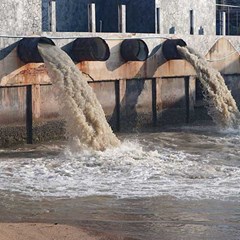Industrial Waste Water Treatment-- Eco-Friendly Solutions for Water Recycling
Wiki Article
Trick Techniques in Hazardous Waste Water Therapy Processes
The therapy of industrial wastewater is an essential aspect of ecological monitoring, involving a variety of techniques created to mitigate the effect of contaminants. Developments in innovations such as membrane layer filtration and advanced oxidation processes provide innovative remedies for boosting therapy effectiveness.Physical Therapy Methods
How effectively can physical therapy approaches address the complexities of commercial wastewater? Physical therapy techniques play a critical function in the initial phases of wastewater administration, focusing mainly on the removal of solids and huge particulates. Strategies such as sedimentation, flotation, and purification are crucial for reducing the concentration of put on hold solids, thus improving the performance of succeeding treatment procedures.Sedimentation involves the gravitational settling of solids, allowing for the splitting up of heavier materials from the wastewater. This technique is especially reliable in clearing up water prior to chemical or biological therapies.
Furthermore, flotation protection techniques, which utilize air bubbles to raise suspended solids to the surface area for elimination, are reliable in treating wastewater with high focus of fats, oils, and greases. On the whole, physical therapy methods work as a crucial very first step in the thorough administration of commercial wastewater, ensuring that the load on succeeding therapy stages is lessened and enhancing total therapy efficacy.
Chemical Treatment Techniques
While physical treatment methods lay the groundwork for efficient wastewater administration, chemical therapy strategies are necessary for resolving the a lot more complicated pollutants usually located in industrial effluents. These techniques make use of different chemical agents to precipitate, counteract, or oxidize harmful compounds, making sure an extra extensive elimination of pollutants.
One common strategy is coagulation and flocculation, where chemical coagulants such as light weight aluminum sulfate or ferric chloride are included in promote the aggregation of suspended particles. This process enhances solid-liquid splitting up, reducing turbidity and improving water high quality. Furthermore, neutralization processes are utilized to readjust the pH of wastewater, using acids or bases to counteract acidic or alkaline streams, specifically.
Oxidation-reduction reactions play a critical duty in derogatory organic impurities and microorganisms. Chemical oxidants like chlorine, hydrogen, or ozone peroxide are used to break down complicated natural substances, making them less unsafe or much more eco-friendly. Advanced oxidation procedures (AOPs) incorporate multiple oxidation methods to improve pollutant removal efficiency.
Organic Treatment Processes
The efficiency of wastewater treatment is substantially improved by organic therapy procedures, which harness the all-natural metabolic tasks of microbes to disintegrate natural issue and eliminate toxins. Industrial Waste Water Treatment. These processes mostly entail cardiovascular and anaerobic digestion, each tailored for specific kinds of wastewaterCardiovascular treatment processes utilize oxygen to sustain microbial development, advertising the breakdown of natural toxins into carbon dioxide and water. Common methods consist of triggered sludge systems, where oygenation containers assist in the mixing of wastewater with microorganisms, and flowing filters, which urge biofilm development on media surface areas.
Alternatively, anaerobic treatment procedures happen in the lack of oxygen, making use of anaerobic germs to decompose raw material, resulting in biogas manufacturing, an eco-friendly energy resource. Anaerobic digesters are typically employed in industrial settings for this objective, successfully reducing the quantity of sludge while producing valuable biogas.
The choice additional hints of a biological treatment method relies on wastewater attributes, treatment goals, and regulative standards. The assimilation of biological procedures in wastewater treatment not just boosts contaminant removal performance but likewise promotes sustainability by decreasing chemical usage and supporting source recuperation.
Advanced Oxidation Processes

Typical AOP methods include Fenton's photocatalysis, ozonation, and reagent. Fenton's reagent, a mix of hydrogen peroxide and ferrous iron, catalyzes the formation of hydroxyl radicals, making it effective for treating wastewater consisting of phenolic compounds and other stubborn compounds. Ozonation makes use of ozone as an effective oxidant, capable of deteriorating a vast array of natural contaminants while concurrently disinfecting the effluent. Photocatalysis employs light-activated catalysts, such as titanium dioxide, to improve oxidation responses and eliminate impurities.
AOPs offer a number of advantages, including decreased sludge production and the ability to treat wastewater with high concentrations of natural toxins. Nevertheless, the application of AOPs requires careful factor to consider of functional parameters and cost-effectiveness, making sure that these sophisticated methods are properly integrated into existing wastewater therapy systems.
Membrane Filtering Technologies

Microfiltration is efficient for eliminating suspended solids and germs, while ultrafiltration targets smaller sized natural particles and viruses. Nanofiltration bridges the anchor space between ultrafiltration and reverse osmosis, effectively eliminating divalent ions and natural substances. Reverse osmosis supplies the highest level of purification, utilized mainly for desalination and getting rid of mono-valent ions.
Membrane technologies use countless advantages, consisting of low power consumption contrasted to traditional therapy approaches, modular design for scalability, and the capacity for water recuperation and reuse. Obstacles such as membrane fouling and the demand for regular upkeep should be addressed to make certain system effectiveness. In general, membrane filtration modern technologies stand for a vital component of contemporary commercial wastewater therapy approaches, promoting sustainability and source preservation in water monitoring.
Conclusion
In conclusion, industrial wastewater therapy employs a varied selection of strategies, including physical, chemical, biological, and progressed methods. Continued advancements in these approaches will certainly additionally enhance the efficiency and effectiveness of wastewater treatment processes in commercial setups.The therapy of commercial wastewater is a vital facet of environmental administration, including a range of methods developed to minimize the impact of contaminants.Exactly how successfully can physical treatment methods resolve the complexities of industrial wastewater?Advanced oxidation procedures (AOPs) represent an innovative technique in commercial wastewater therapy, made to successfully degrade organic toxins that are usually immune to standard therapy approaches (Industrial Waste Water Treatment).In final thought, commercial wastewater treatment uses a diverse range of strategies, including physical, chemical, biological, and advanced approaches. Continued innovations in these approaches will additionally boost the effectiveness and efficiency of wastewater treatment procedures in commercial setups
Report this wiki page